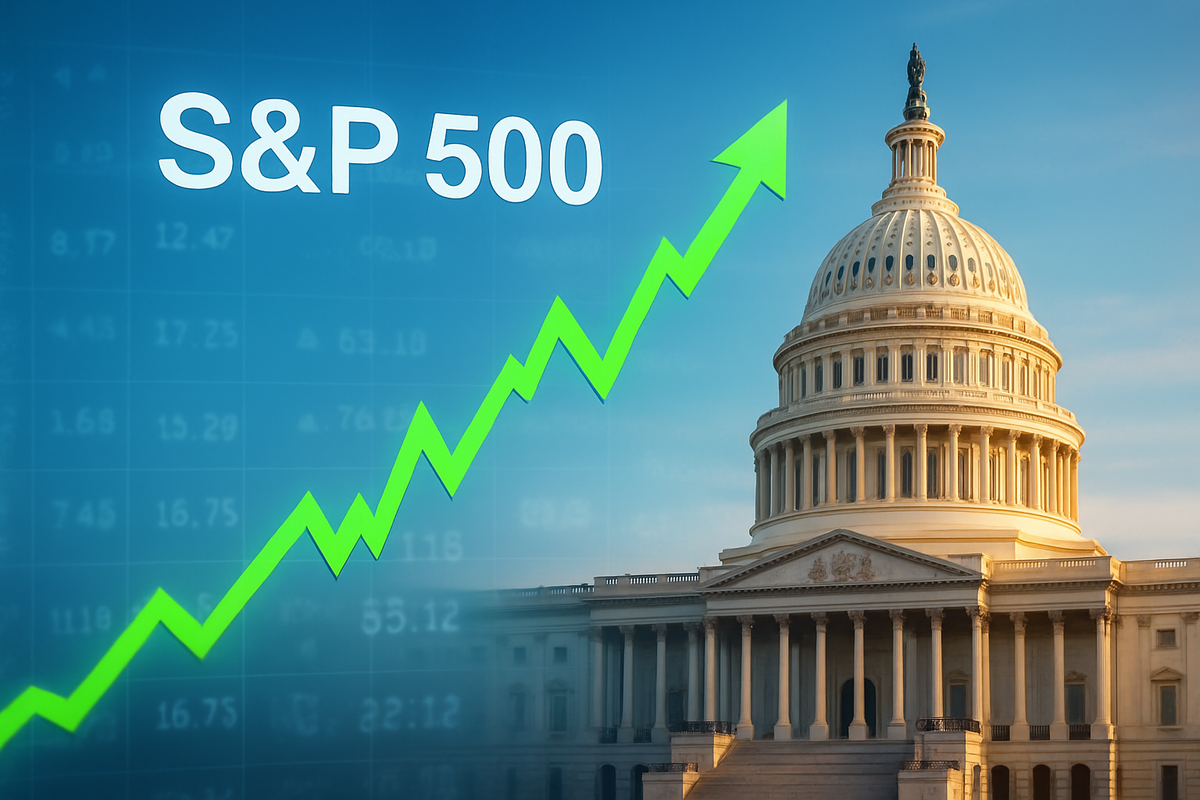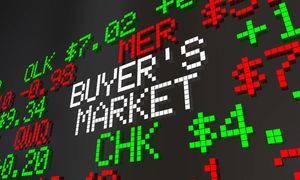
Washington D.C. – November 10, 2025 – Global financial markets are breathing a collective sigh of relief today as the S&P 500 index experiences a significant uplift, signaling investor optimism over imminent legislative progress to resolve the prolonged U.S. government shutdown. After weeks of political deadlock, congressional lawmakers are reportedly taking decisive steps towards a bipartisan agreement, sparking a robust "risk-on" sentiment across asset classes and offering a much-needed jolt to an economy navigating uncertainty.
The prospect of federal agencies resuming full operations and the release of crucial economic data have fueled this market rally. While the shutdown has exacted a toll on various sectors and left millions of federal workers in limbo, the market's swift positive reaction underscores a historical tendency to rebound sharply once political impasses are overcome. This current surge suggests that investors are keen to put the political drama behind them and refocus on underlying economic fundamentals.
Legislative Breakthrough Ignites Market Confidence
The current government shutdown, which commenced on October 1st and has now stretched beyond 40 days, has been one of the longest in recent memory. It began when Congress failed to pass the necessary appropriations bills to fund federal operations for the fiscal year. The impasse centered on contentious policy riders attached to spending legislation, particularly regarding healthcare subsidies and border security funding, leading to a stalemate between the White House and Capitol Hill.
Today's breakthrough comes after intense, behind-the-scenes negotiations led by key congressional figures. Sources indicate that a bipartisan group of senators, including moderates like Senators Shaheen, Hassan, and King, successfully brokered a compromise that gained traction in both chambers. The legislative steps towards resolution typically involve passing a continuing resolution (CR) to fund the government temporarily or, less commonly, passing all 12 annual appropriations bills. The current deal is rumored to be a short-term CR, designed to provide funding through the end of the year, allowing more time for a comprehensive budget agreement.
Initial market reactions have been overwhelmingly positive. The S&P 500, which had shown remarkable resilience with a 0.6% gain even during the shutdown, jumped by 1% on news of the impending deal. This "risk-on sentiment" led to a strong open in U.S. stocks, reflecting improved investor confidence and a reduced political risk premium. The return of essential government functions and the resumption of economic data releases are expected to further bolster this positive momentum, allowing markets to pivot back to assessing corporate earnings and broader monetary policy.
Companies Poised for Gains and Those Facing Lingering Headwinds
The resolution of the government shutdown is expected to create a wave of relief and opportunity for numerous public companies, particularly those directly tied to federal spending and regulatory processes.
Government contractors stand to be among the most immediate beneficiaries. Companies like Lockheed Martin (NYSE: LMT), a major defense contractor, and IT service providers such as Leidos Holdings (NYSE: LDOS) and Booz Allen Hamilton (NYSE: BAH), have faced delayed payments, frozen contracts, and operational disruptions. With the government reopening, these firms anticipate the resumption of projects, the release of overdue payments, and the awarding of new contracts, significantly boosting their revenue and cash flow. Smaller and mid-sized contractors, which often operate on tighter margins, will particularly welcome this relief.
Industries reliant on regulatory approvals will also see significant benefits. Pharmaceutical and biotechnology companies, for instance, have been awaiting critical FDA reviews of new drug applications. Firms like Exelixis (NASDAQ: EXEL) can now expect these crucial approvals to proceed, potentially accelerating market access for new products. Similarly, the Initial Public Offering (IPO) market, which often experiences a temporary halt during shutdowns due to delayed SEC reviews, can now move forward with planned offerings. The financial services sector, including major players like JPMorgan Chase & Co. (NYSE: JPM) and Bank of America Corp. (NYSE: BAC), is also expected to rally as political risk premiums unwind and investor confidence improves.
Conversely, while the overall sentiment is positive, some companies might still face lingering challenges. Smaller businesses and contractors, even with the promise of back pay, may have incurred significant debt or suffered irreversible operational losses during the prolonged shutdown, making their recovery bumpier. Furthermore, the specific details of the legislative resolution could have targeted impacts. For example, if the compromise involves certain spending cuts or exclusions, companies heavily reliant on those specific federal programs could still face headwinds.
Broader Economic Implications and Historical Context
The resolution of a U.S. government shutdown, while a positive catalyst for markets, also casts a spotlight on broader economic trends and vulnerabilities. During the recent 40-day impasse, economists estimate a reduction in annualized GDP growth, with some analyses suggesting that around 30% of shutdown-related economic activity represents a permanent loss. This impact stems from furloughed workers, halted government services, and delayed business decisions. Consumer confidence and spending patterns, which typically take weeks to fully recover, will be closely watched as key indicators of economic health.
The ripple effects extend globally. As the world's largest economy, U.S. stability significantly impacts international markets. News of the resolution has already triggered a global "relief rally," benefiting export-oriented nations and companies worldwide. However, the disruptions to international commerce, including delays in customs processing and trade negotiations during the shutdown, have underscored the U.S.'s role as a reliable commercial partner. The resolution is expected to normalize global supply chains and restore confidence in trade relations.
Historically, the S&P 500 has shown remarkable resilience in the face of government shutdowns. While performance during shutdowns can be flat or slightly positive, the index has consistently delivered positive returns in the 12 months following a resolution, averaging around 12.7%. This trend suggests that investors generally view these political events as temporary, with long-term market performance driven more by fundamental economic conditions, corporate earnings, and Federal Reserve policy. The 2018-2019 shutdown, for instance, was followed by a 23.7% gain in the subsequent year, partly due to a dovish pivot by the Federal Reserve.
The Path Forward: Opportunities and Lingering Uncertainties
Looking ahead, the resolution of the government shutdown paves the way for both short-term market opportunities and long-term economic recalibration. In the immediate future, the equity market is likely to sustain its relief rally, with technology stocks and cyclical sectors often leading gains as investor confidence and risk appetite improve. The re-injection of liquidity into the market from the Treasury General Account (TGA), which accumulated cash during the shutdown, could further fuel a year-end rally, particularly benefiting liquidity-sensitive assets like small-cap stocks.
However, the path to full economic recovery may be gradual. The coming weeks will see the release of delayed federal economic data, including jobs reports, inflation figures, and GDP updates. This influx of information will be critical for investors and, crucially, for the Federal Reserve, which has been operating in an "economic fog." The Fed's assessment of the shutdown's actual impact will heavily influence its future monetary policy decisions, including potential interest rate adjustments. A dovish shift could provide a significant boost, while unexpectedly weak data could temper market enthusiasm.
Potential market opportunities include continued strength in sectors that were directly impacted by the shutdown (e.g., government contractors, travel, and leisure) as deferred spending resumes. Companies involved in infrastructure could also benefit from any post-reopening fiscal stimulus. Challenges may arise from lingering consumer pessimism, which could suppress discretionary spending, and persistent regulatory backlogs that affect businesses reliant on federal permits and approvals. The ultimate scenario for economic recovery will depend on the duration and severity of the shutdown's effects, coupled with the agility of monetary and fiscal policy responses.
A Resilient Market Navigates Political Headwinds
In summary, the S&P 500's robust ascent following news of a breakthrough in ending the U.S. government shutdown underscores the market's inherent resilience and its eagerness to move past political gridlock. Key takeaways include the strong historical tendency for equity markets to rally post-shutdown, the immediate relief for government contractors and regulated industries, and the broader economic implications of disrupted federal operations.
Moving forward, investors should closely monitor the cascade of delayed economic data, which will provide a clearer picture of the shutdown's true impact and guide the Federal Reserve's policy decisions. Consumer and business confidence trends will be vital indicators of the pace of economic recovery. Furthermore, corporate earnings reports and guidance from companies with federal exposure will offer granular insights into sector-specific recoveries.
While the immediate crisis appears to be averted, the underlying political divisions that led to this shutdown could persist, raising concerns about future fiscal stability. Investors should remain vigilant for any signs of renewed political risk that could impact U.S. creditworthiness or introduce further market volatility. Ultimately, the market's ability to sustain its positive trajectory will hinge on a combination of improving economic fundamentals, a supportive monetary policy environment, and a sustained period of political stability.
This content is intended for informational purposes only and is not financial advice






